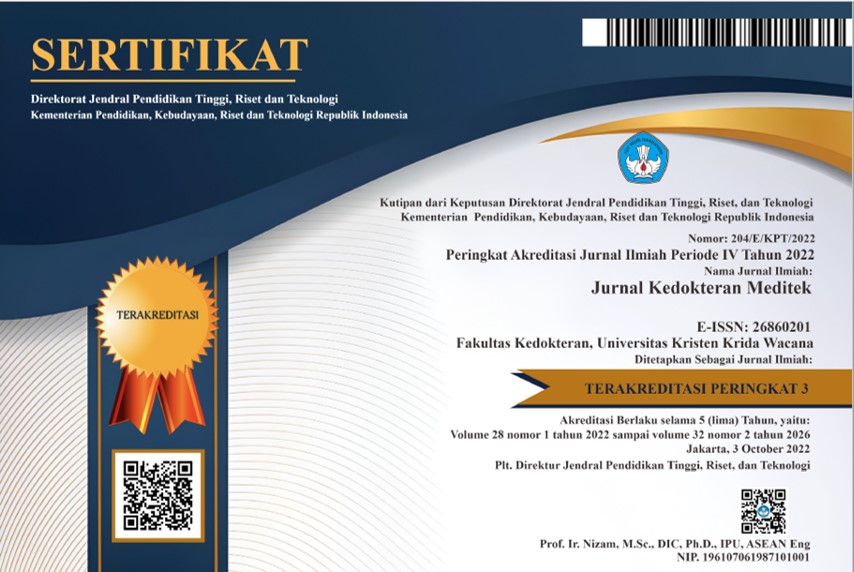Deteksi Bakteri Coliform pada Es Batu yang Disajikan di Tempat Makan Tenda di Kecamatan Grogol Petamburan
DOI:
https://doi.org/10.36452/jkdoktmeditek.v26i2.1840Keywords:
coliform bacteria, ice cube, Most Probable Number, street foodAbstract
Bacteria contamination in ice cube may come from poor hygiene process including dirty ice cube maker appliances and the use of unclean water. According to the Indonesian government regulation (BPOM RI No. 16 of 2016 about microbiology criteria for processed food), the standard for Escherichia coli and coliform bacteria content in drinking water is 0/250ml. Grogol Petamburan area is a location where most students of the Faculty of Medicine Ukrida live, therefore the author was interested to do this research. This study aimed to detect the presence of coliform bacteria in ice cube sold by street food vendors. This study used an observational descriptive study method. Ice cube samples were obtained from 10 street vendors in Grogol Petamburan area. Samples were tested based on TPC and MPN methods to detect coliform bacteria. Results showed that coliform bacteria and fecal coliform were detected in all ice cube samples. It can be concluded that all ice samples are not good for consumption according to the microbiological requirements.
References
2. Brooks F, Morse A, Carroll C, Mietzner A, Jawetz BS, Melnick. Adelberg’s medical microbiology. 26th ed. New York: McGraw-Hill Medical. 2013.
3. Nkere C, Ibe N, Iroegbu C. Bacteriological quality of foods and water sold by vendors and in restaurants in Nsukka, Enugu State, Nigeria: A comparative study of three microbiological methods. Journal of Health, Population and Nutrition, 2012;29(6).
4. Mukhopadhyay C, Vishwanath S, Eshwara VK. Introduction: infectious diseases caused by pathogenic bacteria, viruses and parasites are the most commonand widespread health risk associated with drinking water. King Saud Bin Abdulaziz University for Health Sciences; 2012.
5. Schijven JF, Teunis PFM, Rutjes SA, Martijn Bouwknegt, Ana Mariade Roda Husman. QMRAspot: A tool for Quantitative Microbial Risk Assessment from surface water to potable water. National Institute for Public Health and the Environment, Expert Centre for Methodology and Information Services. Bilthoven, The Netherlands. Water Research. 2011;(45:17); 5564-76.
6. Mohamed A.Hamouda, XiaohuiJin, HeliXu, FeiChen. Quantitative microbial risk assessment and its applications in small water systems: A review. Science of The Total Environment. 2018; (15); 993-1002.
7. Centers for Disease Control and Prevention, National Center for Emerging and Zoonotic Infectious Diseases (NCEZID), Division of Foodborne, Waterborne, and Environmental Diseases (DFWED). Enteric Diseases Epidemiology Branch. CDC’s lead epidemiology and surveillance group for tracking pathogens and identifying sources for bacterial enteric (intestinal) infections transmitted by food and other routes. 2018.
8. Felicity C.T.Elder, Edward J.Feil, JasoN.Snape. The role of stereochemistry of antibiotic agents in the development of antibiotic resistance in the environment. Environment International. 2020;(139):105681.
9. Dehbanipour, R., H. Khanahmad, M. Sedighi, A. Zahedi Bialvaei, and J. Faghri. High prevalence of fluoroquinolone-resistant Escherichia coli strains isolated from urine clinical samples. J Prev Med Hyg. 2019;60(1):E25–30.
10. Pasaribu D. Escherichia coli O157:H7 pembawaShiga like toxin. Jurnal Kedokteran Meditek. 2012;18 (46).
11. Centers for Disease Control and Prevention, National Center for Emerging and Zoonotic Infectious Diseases (NCEZID), Division of Foodborne, Waterborne, and Environmental Diseases (DFWED). A Guide to Drinking Water Treatment Technologies for Household Use. 2014.
12. Awuor L, Thompson S, Thompson B, Liberda E, Meldrum R. Microbiological quality and handling practices of ice served in selected downtown Toronto food premises. Environmental Health Review. 2016;59(3):83-7.
13. Gaglio R, Francesca N, Di Gerlando R, Mahony J, De Martino S, Stucchi C et al. Enteric bacteria of food ice and their survival in alcoholic beverages and soft drinks. Food Microbiology. 2017;67:17-22.
14. Kriteria Mikrobiologi dalam Pangan Olahan. Peraturan Kepala Badan Pengawas Obat Dan Makanan Republik Indonesia Nomor 16 Tahun 2016. 2016;49.
15. Making agar plates. [Internet]. University of Utah [cited 12 June 2019]. Teach Genetics Utah. Available from: https://teach.genetics.utah.edu/content/microbiology/plates/
16. Tristyanto N. Uji bakteriologi MPN Koliform dan Escherichia coli pada air baku kolam renang di Kota Malang. PT Semesta Anugerah. 2018; 7-18.
17. API 20E Test System: Introduction, procedure results and interpretations [Internet]. [cited 11 April 2019]. Available from: https://microbeonline.com/api-20e-test-system-introduction-procedure-results-interpretations/
18. Rahmaniar SA, Habib I. Perbandingan kualitas es batu di warung makan dengan restoran di DIY dengan indikator jumlah bakteri Coliform dan Escherichia coli terlarut. Mutiara Medika. 2011;11(3):150-8.
19. Budi S, Renatalia F, Mevy T, Ria U. Determination of coliform bacteria contamination on household ice cube in bukittinggi. International Journal of Green Pharmacy. 2018;23.
20. Olianovi, N., & R.Pasaribu, D. Menghitung Escherichia coli fekal dari air cucian selada di pasar wilayah kecamatan Grogol. Jurnal Kedokteran Meditek. 2017;23(61)
21. Rosadini Pasaribu, D., Arly, F., & Gunadi, W. (2019). Penilaian Kualitas Air Minum Produk Smart Water Station Berdasarkan Parameter Mikrobiologi Menggunakan Metode Most Probable Number di Fakultas Kedokteran UKRIDA. Jurnal Kedokteran Meditek. 2019;25(2): 66-74

















